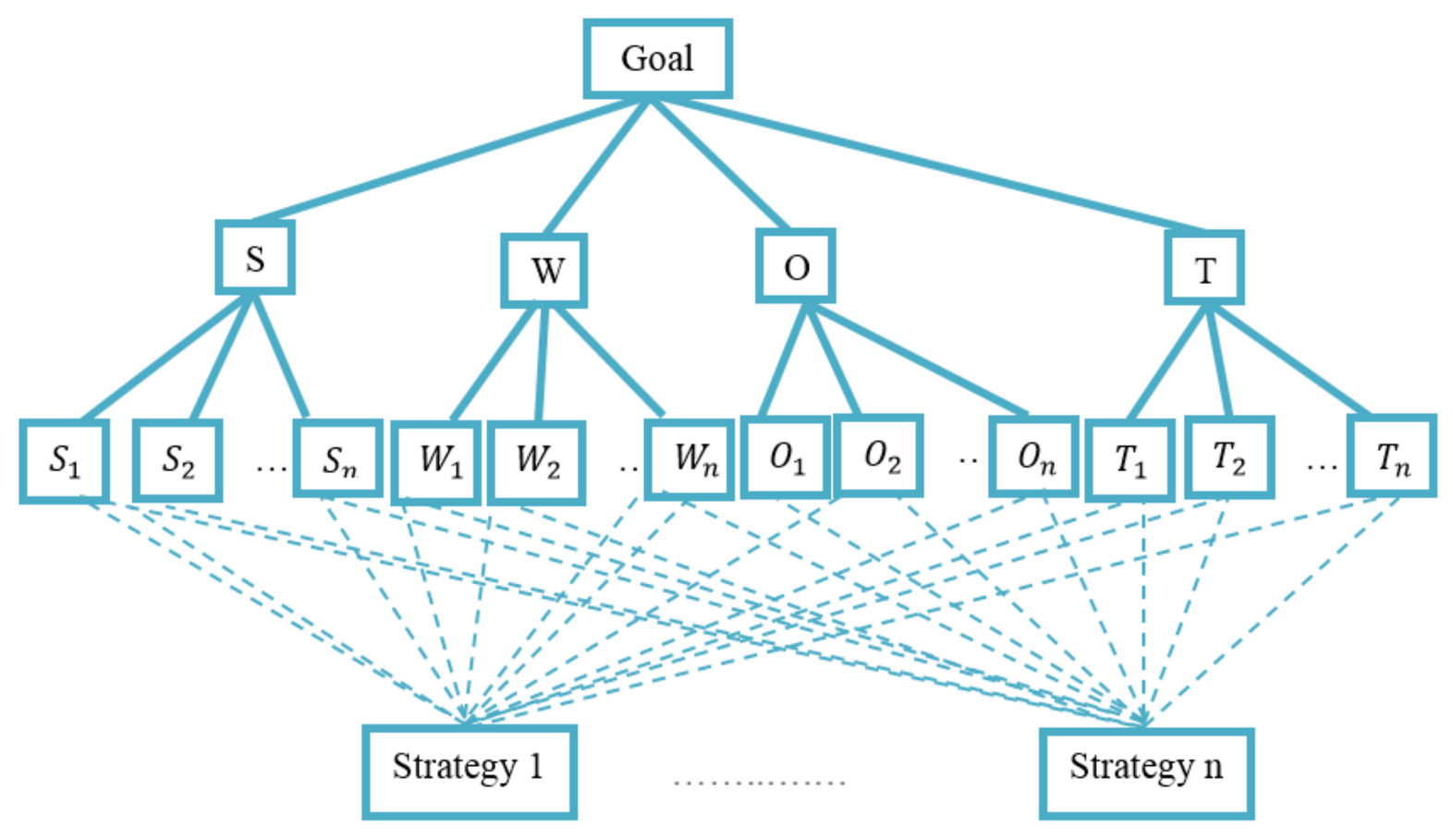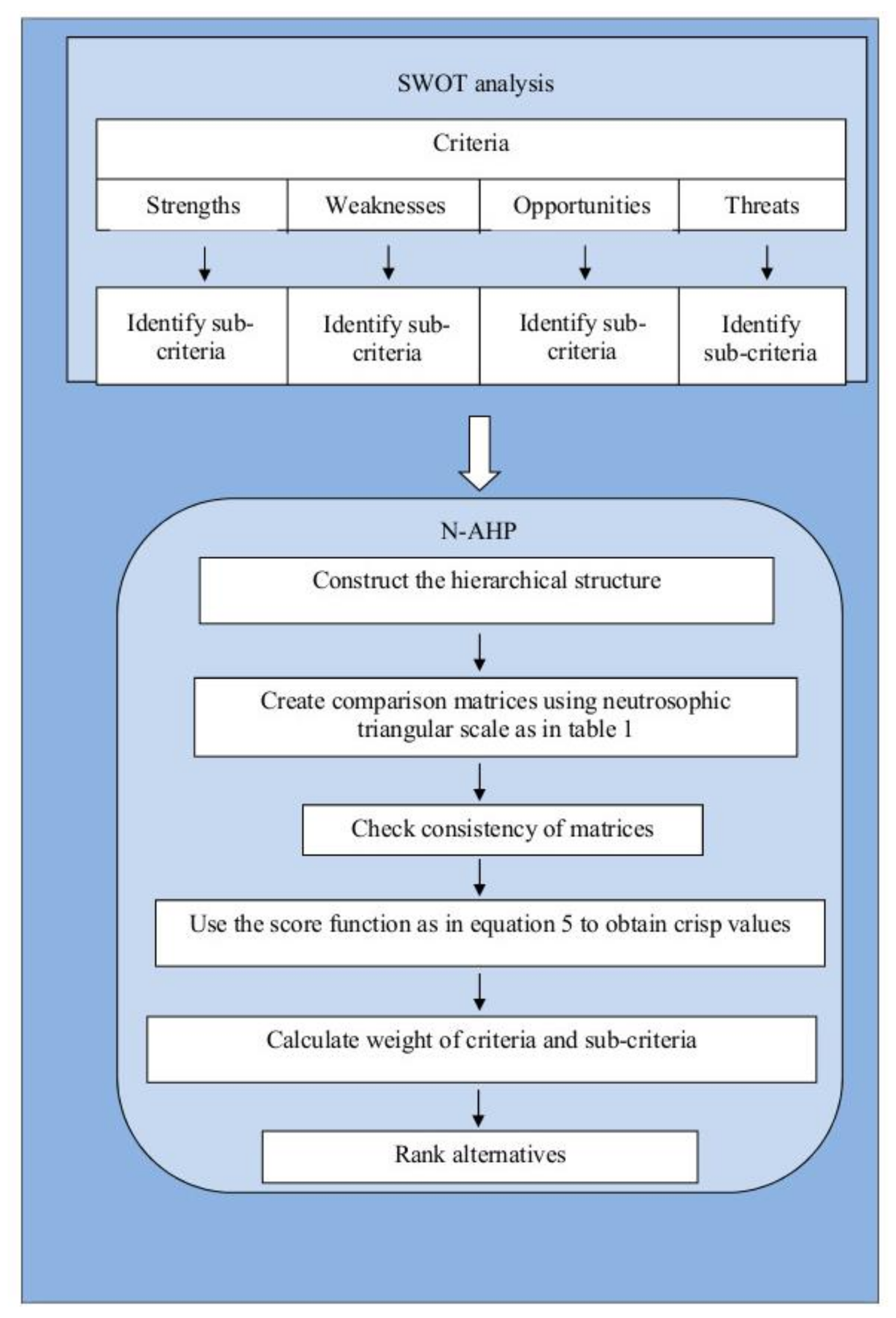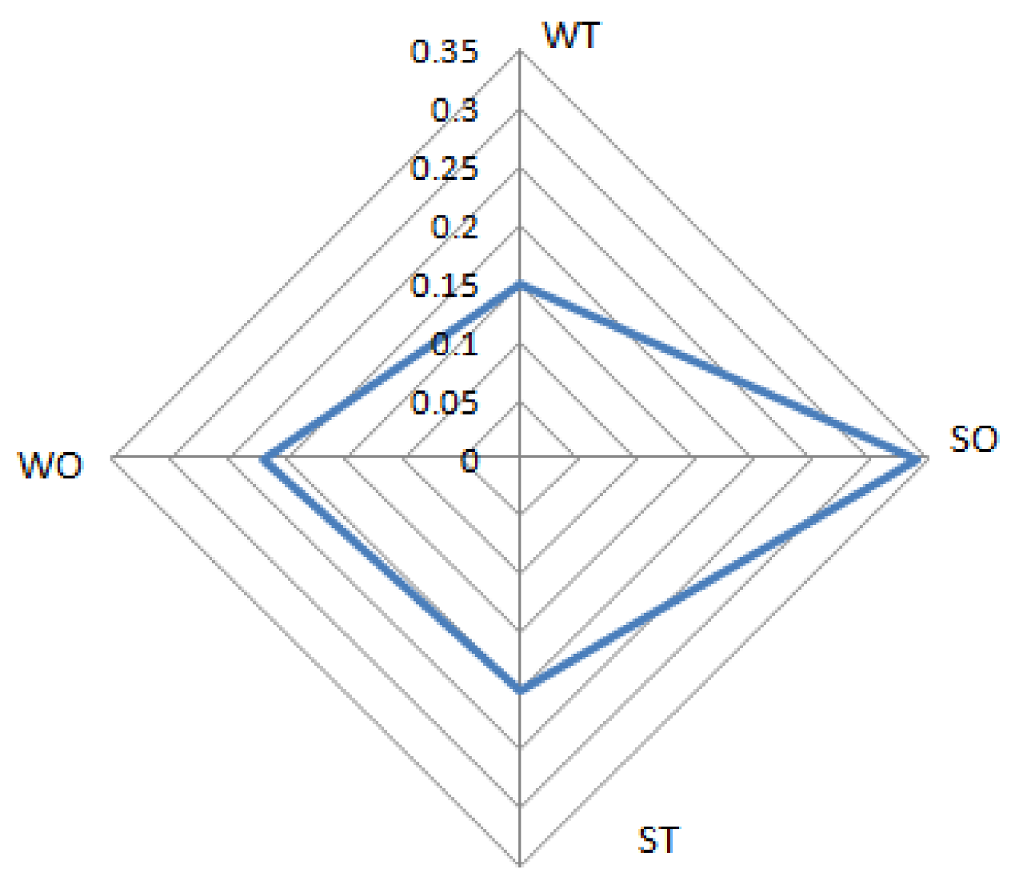1. Introduction
To achieve an organization’s goals, the strategic factors affecting its performance should be considered. These strategic factors are classified as internal factors, that are under its control, and external factors, that are not under its control.
The most popular technique for analyzing strategic cases is SWOT analysis. SWOT is considered a decision-making tool. The SWOT acronym stands for Strengths, Weaknesses, Opportunities and Threats [
1]. Strengths and weaknesses are internal factors, while opportunities and threats are external factors. The successful strategic plan of an organization should focus on strengths and opportunities, try to handle weaknesses, and avoid or mitigate threats.
By using SWOT analysis, an organization can choose one of four strategic plans as follows:
SO: The good use of opportunities through existing strengths.
ST: The good use of strengths to eliminate or reduce the impact of threats.
WO: Taking into account weaknesses to obtain the benefits of opportunities.
WT: Seeking to reduce the impact of threats by considering weaknesses.
SWOT analysis can be used to build successful company strategies, but it fails to provide evaluations and measures. Therefore, in the present research, we integrated it with the neutrosophic analytic hierarchy process (AHP).
The analytic hierarchy process (AHP) is a multi-criterion decision-making technique (MCDM) used for solving and analyzing complex problems. MCDM is an important branch in operations research, when seeking to construct mathematical and programming tools to select the superior alternative between various choices, according to particular criteria.
The AHP consists of several steps. The first step is structuring the hierarchy of the problem to understand it more clearly. The hierarchy of the AHP consists of a goal (objective), decision criteria, sub-criteria, and, finally, all available alternatives.
After structuring the AHP hierarchy, pair-wise comparison matrices are constructed by decision makers to weight criteria using Saaty’s scale [
2].
Finally, the final weight of alternatives are determined and ranked.
Then, the AHP is able to estimate both qualitative and the quantitative elements. For this reason, it is one of the most practical multi-criteria decision-making techniques [
3].
In real life applications, decision criteria are often vague, complex and inconsistent in nature. In addition, using crisp values in a comparison matrix is not always accurate due to uncertainty and the indeterminate information available to decision makers. Many researchers have begun to use fuzzy set theory [
4]. However, fuzzy set theory considers only a truth-membership degree. Atanassov introduced intuitionistic fuzzy set theory [
5], which considers both truth and falsity degrees, but it fails to consider indeterminacy. To deal with the previous drawbacks of fuzzy and intuitionistic fuzzy sets, Smarandache introduced neutrosophic sets [
6], which consider truth, indeterminacy and falsity degrees altogether to represent uncertain and inconsistent information. Therefore, neutrosophic sets are a better representation of reality. For this reason, in our research, we employed the AHP under a neutrosophic environment.
This research represents the first attempt at combining SWOT analysis with a neutrosophic analytic hierarchy process.
The structure of this paper is as follows: a literature review of SWOT analysis and the AHP is presented in
Section 2; the basic definitions of neutrosophic sets are introduced in
Section 3; the proposed model is discussed in
Section 4; a real case study illustrates the applicability of the model proposed in
Section 5; and, finally,
Section 6 concludes the paper, envisaging future work.
2. Literature Review
In this section, we present an overview of the AHP technique and SWOT analysis, which are used across various domains.
SWOT analysis [
7] is a practical methodology pursued by managers to construct successful strategies by analyzing strengths, weaknesses, opportunities and threats. SWOT analysis is a powerful methodology for making accurate decisions [
8]. Organization’s construct strategies to enhance their strengths, remove weaknesses, seize opportunities, and avoid threats.
Kotler et al. used SWOT analysis to attain an orderly approach to decision-making [
9,
10,
11]. Many researchers in different fields [
4] apply SWOT analysis. An overview of the applications of SWOT analysis is given by Helms and Nixon [
8]. SWOT analysis has been applied in the education domain by Dyson [
12]. It has also been applied to healthcare, government and not-for-profit organizations, to handle country-level issues [
13] and for sustainable investment-related decisions [
14]. It has been recommended for use when studying the relationships among countries [
15]. SWOT analysis is mainly qualitative. This is the main disadvantage of SWOT, because it cannot assign strategic factor weights to alternatives. In order to overcome this drawback, many researchers have integrated it with the analytic hierarchy process (AHP).
Since the AHP is convenient and easy to understand, some managers find it a very useful decision-making technique. Vaidya and Kumar reviewed 150 publications, published in international journals between 1983 and 2003, and concluded that the AHP technique was useful for solving, selecting, evaluating and making decisions [
16]. Achieving a consensus decision despite the large number of decision makers is another advantage of the AHP [
17].
Several researchers have combined SWOT analysis methodology with the analytic hierarchy process (AHP). Leskinen et al. integrated SWOT with the AHP in an environmental domain [
18,
19,
20], Kajanus used SWOT–AHP in tourism [
21], and Setwart used SWOT–AHP in project management [
22]. Competitive strength, environment and company strategy, were integrated by Chan and Heide [
23]. Because the classical version of the AHP fails to handle uncertainty, many researchers have integrated SWOT analysis with the fuzzy AHP (FAHP). Demirtas et al. used SWOT with the fuzzy AHP for project management methodology selection [
24]. Lumaksono used SWOT-FAHP to define the best strategy of expansion for a traditional shipyard [
25]. Tavana et al. integrated SWOT analysis with intuitionistic fuzzy AHP to outsource reverse logistics [
26].
Fuzzy sets focus only on the membership function (truth degree) and do not take into account the non-membership (falsity degree) and the indeterminacy degrees, so fail to represent uncertainty and indeterminacy. To overcome these drawbacks of the fuzzy set, we integrated SWOT analysis with the analytic hierarchy process in a neutrosophic environment.
A neutrosophic set is an extension of a classical set, fuzzy set, and intuitionistic fuzzy set, and it effectively represents real world problems by considering all facets of a decision situation, (i.e., truthiness, indeterminacy and falsity) [
27,
28,
29,
30,
31,
32,
33,
34,
35,
36,
37,
38,
39,
40,
41,
42,
43,
44,
45,
46,
47,
48]. This research attempted, for the first time, to present the mathematical representation of SWOT analysis with an AHP in a neutrosophic environment. The neutrosophic set acted as a symmetric tool in the proposed method, since membership was the symmetric equivalent of non-membership, with respect to indeterminacy.
4. Neutrosophic AHP (N-AHP) in SWOT Analysis
This section describes the proposed model of integrating SWOT analysis with the neutrosophic AHP. A step-by-step procedure for the model described is provided in this section.
- Step 1
Select a group of experts at performing SWOT analysis.
In this step, experts identify the internal and the external factors of the SWOT analysis by employing questionnaires/interviews.
Figure 1 presents the SWOT analysis diagram:
To transform a complex problem to a simple and easy to understand problem, the following step is applied:
- Step 2
Structure the hierarchy of the problem.
The hierarchy of the problem has four levels:
The first level is the goal the organization wants to achieve.
The second level consists of the four strategic criteria that are defined by the SWOT analysis (i.e., criteria).
The third level are the factors that are included in each strategic factor of the previous level (i.e., sub-criteria).
The final level includes the strategies that should be evaluated and compared.
The general hierarchy is presented in
Figure 2.
The next step is applied for weighting factors (criteria), sub-factors (sub-criteria) and strategies (alternatives), according to experts’ opinions.
- Step 3
Structure the neutrosophic pair-wise comparison matrix of factors, sub-factors and strategies, through the linguistic terms which are shown in
Table 1.
The neutrosophic scale is attained according to expert opinion.
The neutrosophic pair-wise comparison matrix of factors, sub-factors and strategies are as follows:
where
, and is the triangular neutrosophic number that measures the decision makers vagueness.
- Step 4
Check the consistency of experts’ judgments.
If the pair-wise comparison matrix has a transitive relation, i.e.,
for all
and
, then the comparison matrix is consistent [
38], focusing only on the lower, median and upper values of the triangular neutrosophic number of the comparison matrix.
- Step 5
Calculate the weight of the factors (S, W, O, T), sub-factors and strategies/alternatives (Alt1,…,Altn) from the neutrosophic pair-wise comparison matrix, by transforming it to a deterministic matrix using the following equations.
Let
be a single valued triangular neutrosophic number; then,
and
which are the score and accuracy degrees of
respectively.
To get the score and the accuracy degree of
, we use the following equations:
With compensation by score value of each triangular neutrosophic number in the neutrosophic pair-wise comparison matrix, we derive the following deterministic matrix:
Determine the ranking of priorities, namely the Eigen Vector X, from the previous matrix as follows:
- Step 6
Calculate the total priority of each strategy (alternative) for the final ranking of all strategies using Equation (10).
The total weight value of the alternative
j can be written as follows:
where
) and
are the weights of Strengths, Weaknesses, Opportunities and Threats; (
) are the sub-factor weights; and
is the weight of the alternative
j, corresponding to its sub-factor.
From previous steps, we obtain the phases of integrating SWOT analysis with neutrosophic analytic hierarchy processes, as shown in
Figure 3.
5. Illustrative Example
The model proposed in
Section 3 is used to solve a real case study in this section.
Every company should analyze and dissect itself from time to time, in order to face competition. This is important especially when a company wants to launch a new product, or open a new market, in order to measure its presumptive success. A company can appraise itself honestly and effectively by performing SWOT analysis, which will help it examine its performance by analyzing internal and external factors. Once SWOT analysis is complete, a company will gain more information about its capabilities. For the evaluation process, a multi-criteria decision-making technique should be used. In this research, we used a neutrosophic AHP. A case study is offered in this section to illustrate this process in detail.
The phases for implementing a N-AHP in SWOT analysis are shown in
Figure 4.
Starbucks Company is the most widely prolific marketer and retailer of coffee in the world. The company has branches in 75 countries, with more than 254,000 employees. The company also sells different types of coffee and tea products and has a licensed trademark. The company offers food, in addition to coffee, and this makes it an attractive spot for snacks and breakfast. The company has different competitors, such as Caribou Coffee Company, Costa Coffee, Green Mountain Coffee Roasters and many others. To face competition, a group of experts perform Starbucks SWOT analysis, as shown in
Figure 5. Depending on the SWOT factors and sub-factors, a set of alternatives strategies is developed. Our aim was to prioritize the strategies suggested by company indicators.
These strategies were:
- ❖
SO strategies
- ❖
WO strategies
Adding different forms, new categories and diverse channels of products
Trying to minimize the coffee price
- ❖
ST strategies
- ❖
WT strategies
By applying our proposed model to Starbucks Company, the evaluation process and the selection of different strategies was anticipated to become simpler and more valuable.
- Step 1
Perform SWOT analysis.
Four experts were selected to perform Starbucks Company SWOT analysis, as they had experience in the coffee industry.
To implement the SWOT analysis, we prepared a questionnaire (see
Appendix A) and sent it out online to experts. After obtaining the answers, the internal (Strengths and Weaknesses) and external (Opportunities and Threats) factors were identified, as shown in
Figure 5.
- Step 2
Structure the hierarchy of the problem.
The hierarchical structure of Starbucks Company, according to the proposed methodology, is presented in
Figure 6.
In
Figure 6,
,…,
were the strengths sub-factors, as listed in the SWOT analysis. Also,
,…,
,
,…,
and
,…,
were the weaknesses, opportunities and threats sub-factors of the SWOT analysis, as shown in
Figure 5.
- Step 3
Structure the neutrosophic pair-wise comparison matrix of factors, sub-factors and strategies, through the linguistic terms which are shown in
Table 1. The values in
Table 2 pertain to the experts’ opinions.
The pair-wise comparison matrix of SWOT factors is presented in
Table 2.
- Step 4
Check the consistency of experts’ judgments.
The previous comparison matrix was consistent when applying the method proposed in [
38].
- Step 5
Calculate the weight of the factors, sub-factors and strategies.
To calculate weight, we first transformed the neutrosophic comparison matrix to its crisp form by using Equation (5). The crisp matrix is presented in
Table 3.
Then, we determined the ranking of the factors, namely the Eigen Vector X, from the previous matrix, as illustrated previously in the detailed steps of the proposed model.
The normalized comparison matrix of factors is presented in
Table 4.
By taking the total of the row averages:
The neutrosophic comparison matrix of strengths is presented in
Table 5.
The crisp pair-wise comparison matrix of strengths is presented in
Table 6 and the normalized comparison matrix of strengths is presented in
Table 7.
By taking the total of the row averages:
The neutrosophic comparison matrix of weaknesses is presented in
Table 8.
The crisp comparison matrix of weaknesses is presented in
Table 9.
The normalized comparison matrix of weaknesses is presented in
Table 10.
By taking the total of the row averages:
The neutrosophic comparison matrix of opportunities is presented in
Table 11.
The crisp comparison matrix of opportunities is presented in
Table 12.
The normalized comparison matrix of opportunities is presented in
Table 13.
By taking the total of the row averages:
The neutrosophic comparison matrix of threats is presented in
Table 14.
The crisp comparison matrix of threats is presented in
Table 15.
The normalized comparison matrix of threats is presented in
Table 16.
By taking the total of the row averages:
Similar to the factors and sub-factors calculation methodology, the weights of alternatives (strategies), with respect to sub-factors, were as follows:
The Eigen Vector X of strategies with respect to S1 =
The Eigen Vector X of strategies with respect to S2 =
The Eigen Vector X of strategies with respect to S3 =
The Eigen Vector X of strategies with respect to S4 =
The Eigen Vector X of strategies with respect to W1 =
The Eigen Vector X of strategies with respect to W2 =
The Eigen Vector X of strategies with respect to W3 =
The Eigen Vector X of strategies with respect to O1 =
The Eigen Vector X of strategies with respect to O2 =
The Eigen Vector X of strategies with respect to O3 =
The Eigen Vector X of strategies with respect to T1 =
The Eigen Vector X of strategies with respect to T2 =
The Eigen Vector X of strategies with respect to T3 =
- Step 6
Determine the total priority of each strategy (alternative) and define the final ranking of all strategies using Equation (10).
The weights of SWOT factors, sub-factors and alternative strategies are presented in
Table 17.
According to our analysis of Starbucks Company using SWOT–N-AHP, the strategies were ranked as follows: SO, WO, ST and WT, as presented in detail in
Table 17 and in
Figure 7. In conclusion, SO was the best strategy for achieving Starbuck’s goals since it had the greatest weight value.
To evaluate the quality of the proposed model, we compared it with other existing methods:
The authors in [
18,
19,
20,
21] combined the AHP with SWOT analysis to solve the drawbacks of SWOT analysis, as illustrated in the introduction section, but in the comparison matrices of the AHP they used crisp values, which were not accurate due to the vague and uncertain information of decision makers.
In order to solve the drawbacks of classical AHP, several researchers combined SWOT analysis with the fuzzy AHP [
24,
25,
26]. Since fuzzy sets consider only the truth degree and fail to deal with the indeterminacy and falsity degrees, it also does not offer the best representation of vague and uncertain information.
Since neutrosophic sets consider truth, indeterminacy and falsity degrees altogether, it is the best representation for the vague and uncertain information that exists in the real world. We were the first to integrate the neutrosophic AHP with SWOT analysis. In addition, our model considered all aspects of vague and uncertain information by creating a triangular neutrosophic scale for comparing factors and strategies. Due to its versatility, this method can be applied to various problems across different fields.













